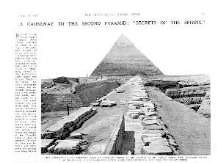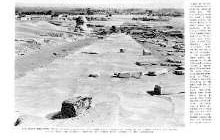|
The Shaft, The Subway
& The Causeway
Part 3
This section reproduces a description of
the discovery of the chambers and shafts under the causeway as
reported in the London Daily Telegraph of the 4th March 1935 and a
report from the Illustrated London News of the 6th April 1935. The
Illustrated London News item is accompanied by two breathtaking
shots of the excavated causeway. The section goes on to reproduce a
description of the site as reported by Chris Ogilvie-Herald and Ian
Lawton via EGYPTNEWS after making their own exploration in October
1998.
Contents
Return to Main Index
page 1│ page 2│ page 3│ page 4│ page 5│
page 6│
page 7│
page 8│ page 9
From Our Own Correspondent...
The following report is taken from the London Daily Telegraph of the
4th March 1935. I am indebted to The Telegraph Group Limited for
allowing it to be reproduced below and also to Chris Ogilvie-Herald
for drawing it to my attention. The report remains © Telegraph Group
Limited, London, 1935
SUBWAY FOUND BELOW THE PYRAMIDS
NEW DISCOVERIES IN EGYPT
COLONNADED HALL IN ROCK
2,500 YEARS' OLD CHAMBERS
FROM OUR OWN CORRESPONDENT
CAIRO, Sunday
 A
subway connecting Khephren's Pyramid City to Cheops' Pyramid
City has been discovered in the course of recent excavations.
This had been cut through the living rock. A
subway connecting Khephren's Pyramid City to Cheops' Pyramid
City has been discovered in the course of recent excavations.
This had been cut through the living rock.
More remarkable still, a shaft, 11 yards long, was found to lead
from the subway to the heart of the rock. When examined, it was
found to end in a chamber some 6 yards by 11 yards.
From one side of it there was a second shaft leading 16 yards
farther down into the rock and ending in a hall somewhat larger
than the upper chamber, with seven smaller chambers leading from
it. In two of these, basalt sarcophagi were found.
From one of these side-chambers a third shaft runs down another
14 yards into the rock, ending in a colonnaded hall, in which
three more basalt sarcophagi were found. So far, the bottom-most
chamber, which is some 65 yards below the surface of the
causeway, has not been investigated, as it is partly under
water.
4th DYNASTY TOMBS
The chambers are, according to Prof. Selim Hassan, the Egyptian
excavator, of the Saitic period (about 600 B.C.). It is known
that between the Saitic and Ptolemaic periods (600 B.C.-200
B.C.) the pyramid area was used as a burial ground, and, that
materials from the 4th Dynasty tombs, dating some 2,800 years
earlier, were used for these later burials.
Indeed, Prof. Selim has been able to reconstruct some of these
4th Dynasty tombs with original material collected from several
points half a mile or so from the tomb itself. But these later
burials have almost always been above the earlier ones.
This quest of a burial place so far below an older burial ground
is most unusual, and recalls the now historic tomb of Hetepheres,
mother of Cheops, which Dr. Reisner so dramatically found hidden
in the living rock some 32 yards below the causeway leading from
Cheops Pyramid to the Pyramid Temple.
Prof. Hassan also found that both the paths on either side of
the causeway leading from Khephren's Pyramid to its temple had
been paved. The latter undoubtedly permitted the undisturbed
passage of the King's "Ka" (spirit) from and to the
burial-place.
© Telegraph Group Limited, London, 1935
Go Back
Illustrated News From Gizeh...
The following item was published in the Illustrated London News
edition of the 6th April 1935. It deals primarily with the
excavation of the causeway and also includes a short reference to
the subway, shafts and chambers beneath the causeway. The
photographs of the causeway immediately after its excavation are of
particular interest. Full-screen images optimised for 800 by 600
display and 70k each in size are available by clicking on the
pictures in the page below.
I am indebted to the Illustrated London News Picture Library for
providing a photographic print of the page and for permitting the
text and pictures to be reproduced here. The material remains © The
Illustrated London News Picture Library and may not be reproduced
elsewhere without their written consent.
A CAUSEWAY TO THE SECOND PYRAMID: "SECRETS
OF THE SPHINX"
|


Click on EACH image
to enlarge |
Recent excavations under Professor
Selim Hassan, undertaken on behalf of the Egyptian University,
have revealed the nature and extent of a causeway, whose
existence had long been suspected, stretching for nearly half a
mile from the Second, or Khephren's Pyramid at Gizeh to
Khephren's valley temple (the so-called Temple of the Sphinx).
The work of clearing the causeway was extremely arduous, since
it was covered with debris, sand, and stones to a depth that
varied between one and fifteen yards.
Once cleared, the causeway proved to be divided into three
separate parts, with a total breadth of some 25 yards. The
middle part was originally a covered road specially devoted to
the passage of the Pharaoh's statue on days of ceremony. The
other two ways were for visitors and sightseers, the priests
alone being allowed to pass up the central causeway and enter
the temple at either end.
The covered way is about 650 yards in total length, and for the
whole distance is finely paved with limestone. Its discovery
confirms the belief that the Sphinx dates from Khephren's reign,
which began in 2766 B.C. Khephren reigned for eighteen years,
but did not live to see the completion of his pyramid.
Other recent discoveries on the site of the royal causeway
include a tunnel, about 300 yards fron the valley temple,
connecting the necropolis of Khufu, builder of the Great
Pyramid, to the north with that of Khephren to the south. Near
its entrance were found shafts leading to several small burial
chambers which contained sarcophagi. Two of these sarcophagi are
of huge size and are made of basalt stone. Further excavations
here are necessary to complete the work.
© Illustrated London News Picture Library
Go Back
The EGYPTNEWS Report...
On Friday 27th November 1998, at a time when hard facts were still
in short supply, co-authors Chris Ogilvie-Herald and Ian Lawton
issued a 'Press Release' via EGYPTNEWS entitled "The Water Shaft -
The Facts" in an attempt to end the speculation about the shaft
under the causeway. The press release included a comprehensive
description of the location which is reproduced below. See the full
text for additional background information.
"Upon climbing down 20 or so feet to the first level chamber of the
"water shaft" one proceeds north to a set of two ladders that drop
down some 45+ feet. There is nothing worthy of note at this upper
level. Climbing down to the second level and turning round to view
this chamber, which is oriented north - south, one sees seven rock
cut sub-chambers: 3 on the right, 3 on the left and one at the far
northern end. Most are empty except for one sub- chamber on the left
and another on the right. Within these two sub-chambers lie granite
sarcophagi, with lids slid to one side and empty save for some
rubbish. These most probably date to the 26th Dynasty.
Over to one's right, on the eastern side, is another vertical shaft
proceeding down to the third level, perhaps some 25 feet below the
second level. Reaching the bottom of the ladder and facing the shaft
wall, one turns around to see a most unusual rock-cut chamber some
100+ feet below ground level. This third chamber or level is
orientated east - west.
Within the centre of this, is a sarcophagus set in a rectangular
depression in the ground, covered by a shallow level of natural
water. Surrounding the coffer is a raised level of rock/soil that
forms a rectangle around the depression, some 2-3 feet wide. On the
outside of this is an outer channel filled with water, itself
surrounded by the chamber walls.
In the north-western corner of the chamber wall is a channel that
diminishes in size, and could have once been a natural water inlet.
In any case it becomes far too small to form a secret passageway to
the pyramids. All levels in the "water shaft" are unadorned and
without hieroglyphs. Although this is an unusual and perhaps unique
chamber, there are no secret passageways heading towards the
Pyramids, Sphinx or underground cities."
About the Authors...
 You might also like to know that Chris and Ian have written a book
called Giza: The Truth, full details of which can be found on the
Amazon website. Click on the book cover for more information. The
book has certainly generated some heated debate, particularly
regarding the age of the Sphinx. Ian has set up the "Giza : The
Truth" Discussion Site so that we can share in the on-going
discussions between the researchers whose theories have been
challenged and the authors. You might also like to know that Chris and Ian have written a book
called Giza: The Truth, full details of which can be found on the
Amazon website. Click on the book cover for more information. The
book has certainly generated some heated debate, particularly
regarding the age of the Sphinx. Ian has set up the "Giza : The
Truth" Discussion Site so that we can share in the on-going
discussions between the researchers whose theories have been
challenged and the authors.
Chris was the founder and operator of the highly regarded EGYPTNEWS
information service. Although Chris took the decision to close down
EGYPTNEWS in January 2002, the EGYPTNEWS Archives are still
available at this time.
Go
Back
|
 A
subway connecting Khephren's Pyramid City to Cheops' Pyramid
City has been discovered in the course of recent excavations.
This had been cut through the living rock.
A
subway connecting Khephren's Pyramid City to Cheops' Pyramid
City has been discovered in the course of recent excavations.
This had been cut through the living rock.

